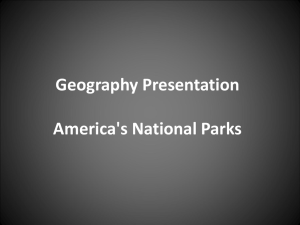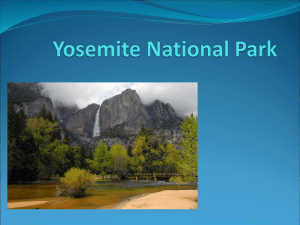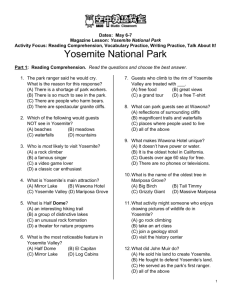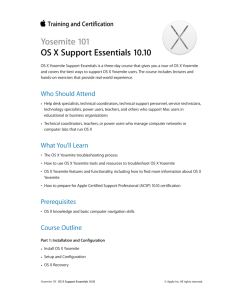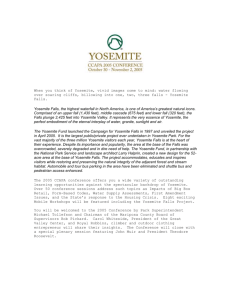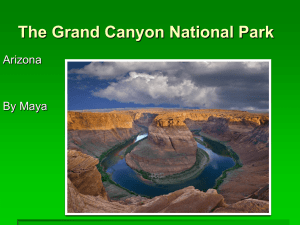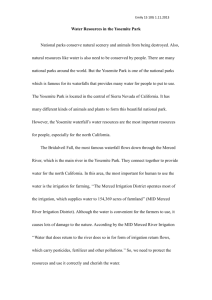VIST OUR NATIONAL PARKS
advertisement
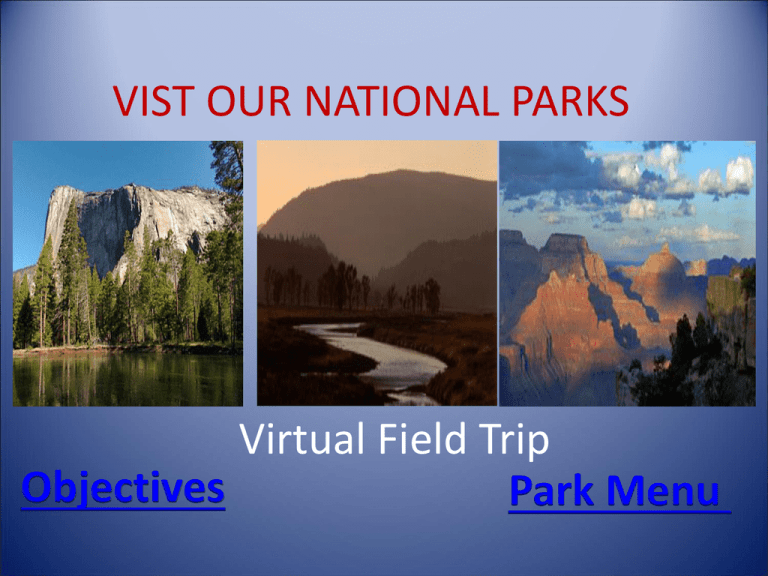
VIST OUR NATIONAL PARKS Virtual Field Trip Objectives Park Menu Objectives You will learn about a few of the United States parks You will learn the location of each park and some of the attractions that each park has. You will learn of some of the plant or animal life in each park. At the end of your trip you will complete the travel journal questions. National Parks Menu Yellowstone Everglades Yosemite Grand Canyon Grand Teton Yellow Stone National Park Facts • Established in 1872, Yellowstone is the world’s first national park. • Yellowstone is located 96% in Wyoming, 3% in Montana and 1% in Idaho • Larger than Rhode Island and Delaware combined. 2.2 million acres total • Over 2,000 earthquakes occur per year inside the park • Reaching a height of 106-184 feet, Old Faithful eruptions are predictable to within 10 minutes, erupting every 46 to 92 minutes. Old Faithful • Old Faithful is a cone geyser located in Wyoming, in Yellowstone National Park • Eruptions can shoot 3,700 to 8,400 gallons of boiling water to a height of 106 to 185 feet With a margin of error of 10 minutes, Old Faithful will erupt 65 minutes after an eruption lasting less than 2.5 minutes or 91 minutes after an eruption lasting more than 2.5 minutes Yellowstone Wildlife • 7 species of native ungulates 2 species of bears Approximately 50 species of other mammals 311 recorded species of birds • 18 species of fish 6 species of reptiles 4 species of amphibians Threatened: bald eagle, grizzly bear, lynx Endangered: whooping crane, gray wolf Yosemite Park Facts • Yosemite National Park was established on October 1 1890, and is the Nation's third oldest national park. • Yosemite National Park embraces almost 1,200 square miles of scenic wild lands • The park ranges from 2,000 feet above sea level to more than 13,000 feet • The area's first residents were Native Americans who inhabited the region perhaps as long ago as 7,000 to 10,000 years. EL Captain • El Capitan is a vertical rock formation in Yosemite National Park, located on the north side of Yosemite Valley, near its western end. The granite monolith extends about 3,000foot from base to summit along its tallest face Yosemite Mammals • Black Bears – This incredibly intelligent animal is called “black bear” but can also be brown, blonde, cinnamon, or even white • Mule Deer – One of the easiest animals to find in Yosemite, these deer are also called “Black-Tailed Deer”. • Coyotes - The coyotes in Yosemite are commonly mistaken for wolves • Mountain Lions – These magnificent creatures are rarely seen by humans because they are very secretive. Yosemite Birds • Stellar’s Jay – Possessing a black crest, blue feather coat, and a very noisy voice, the Stellar’s Jay is known as a “thief”. • Raven – Arguably the most intelligent animal in Yosemite, this very large black bird can usually be seen in pairs. • Great-Grey Owl – One of the largest owls in Yosemite, they prefer the oak woodlands of Yosemite Valley Grand Canyon Facts • Is a 277 miles long and up to 18 miles wide • Took 3-6 million years to form; erosion continues to alter its walls today • Includes approximately 70 species of mammals, 250 species of birds, 25 types of reptiles and five species of amphibians • Was formed by the Colorado River, which flows west through the canyon and averages about 300 feet width, 100 feet in depth and flows at an average speed of four miles per hour Colorado River • The Colorado River begins in Rocky Mountain National Park in Colorado. • At an altitude of 9,010 feet, the Colorado begins it's flow southwestward toward the Gulf of California and the Pacific Ocean Grand Canyon Animal Life • Grand Canyon National Park has 75 species of mammals, 50 species of reptiles and amphibians, 25 species of fish, and over 300 species of birds exist. • Two of the park's most celebrated inhabitants are the Albert squirrel and the Kaibab squirrel • Grand Canyon National Park is home to a number of threatened and endangered species Everglades Facts • The Everglades comprise the largest wetlands located in the U.S.A. • While it is often described as a swamp or forested wetland, the Everglades is actually a very slowmoving river. • America’s Everglades are home to 67 threatened or endangered species. • The Everglades is the only place in the world where the American Alligator and the American Crocodile co-exist in the wild. American Alligator • The alligator is a large lizard-shaped reptile with four short legs and widespread toes, five on each front foot and four on the hind feet. • The skin on the alligator is very tough and covered with smooth horny scales in rows • Both male and female alligators are the same color. Everglade Habitats Hammocks Mangroves Slough Pineland Sawgrass Grand Tetons • . The Grand Teton Park is in northwestern Wyoming, due south of Yellowstone. The park covers more than 300,000 acres. • At 13,770 feet, the Grand Teton itself is only the second highest mountain in Wyoming. • The original Grand Teton National Park was established by Congress on February 29, 1929 Grand Teton Wildlife • The Grand Teton National Park is home to abundant wildlife. Black bears, wolves, elk, moose, bison, pine martens, and red squirrels are relatively common] • There are also some coyotes, badgers, and even grizzly bears and mountain lions. • There are no poisonous snakes or spiders inhabiting the area.
